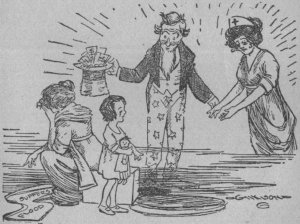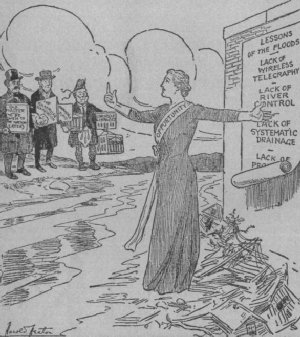HUMAN LIVES SNUFFED OUT BY WATERS
EXPLOSION SENDS BURNING HAY FLOATING IN MIDST OF HOUSES, A FLARING TORCH OF DESTRUCTION—RESCUER IS LOST—ONE RAY OF GLADNESS, "JIM IS SAFE" —LEAPS FROM SKIFF.
Here is the story of George H. Schaefer, a rescuer who went out into the flood with a skiff and saved a woman and baby at Dayton.
"A house that had been torn from its foundation came floating up behind us," said Schaefer. "The woman was frightened. I told her there was no danger.
"Suddenly she stood up and jumped over with her baby in her arms. She went straight down and never came up again."
Then there was the horror that Bill Riley, former clerk of the United States court at Cincinnati and now a salesman for the National Cash Register Co., saw himself.
"We saw a very old woman standing at the window of a house waiting for rescue," said Riley. "We rowed up to it. Suddenly the house parted and the woman in it was engulfed. It was the last we saw of her."
Then there was the man who, almost rescued, had stepped into the skiff and then walked back into his home, which a short time later floated away with him.
And there’s the story of the colored mother who was being rowed to safety with her two babies when the skiff struck a tree and the little craft capsized, so that the babies were drowned. The mother was rescued by Robert Burnham, owner of the skiff, only to die before she reached the hospital.
John Scott, an employe of the National Cash Register Co., who came recently from Butte, Mont., ascended a telegraph pole and guided across the cable to places of safety men, women and children rescued from flooded houses.
It would have seemed unreal if presented in a melodrama, this method of bridging a flood, but here it was done in the presence of hundreds who stood at safe spots appalled by the imminence of danger.
Scott had guided a dozen persons across the swaying bridge of wire when the explosion that started the fire occurred. The shock knocked Scott from the pile and he fell into a tree.
"The last I saw of him he was trying to get into the window of an abandoned house by way of one of the branches of the tree."
The explosion blew a stable filled with hay into the middle of the flooded street, and this carried the flames to the opposite side.
The next house to burn was Harry Lindsay’s, then Mary Kreidler’s, and then the home of Theodore C. Lindsay. Houses that had been carried away from their foundations floated into the flames and soon were burning.
The fires burned without restraint because engines could not get near.
At dawn there was left only the ashes of these homes.
The search for the dead did not begin until all the living were helped.
The most heart-tearing feature of the situation was the pitiable terror of the women and children.
Many of them sat up and sobbed throughout the night, refusing to believe their fathers and husbands were safe, and husbands and fathers who missed wives and children cried their grief in the nerve-shaking way that strong men have of voicing sorrow.
Children were lost, having been parted from their mothers in the turmoil.
Dayton was a lost city for three days. It was completely separated from the rest of the world; its isolation was almost primeval; only one telephone line was working, and that a private wire between Dayton and Lebanon.
Between the city and safety was a whirlpool. Only a mile intervened, but it might be 1,000 or 5,000, for no word of what happened beyond the whirlpool came across the brief mile of water.
The big hotels, crowded with guests, were partially under water. The theaters were flooded. The wares of the department stores floated away. The jail, filled with prisoners, was inundated. The fashionable churches were awash inside, and at St. Elizabeth’s hospital 600 patients were imprisoned in the floods.
All telephone communication was cut off, and none beyond the flood zone knew what disaster had overtaken that part of Dayton which was the center of its enormous wealth. There was nothing but the desolate glare of the flames on Wednesday night to light up the tragedy and its mysteries.
After a night of terror that part of Dayton which had homes to sleep in woke with aching hearts.
The flames showed men, women and children perched on the roofs of houses in the path of the flames, waiting helplessly for the flames to devour them.
Men ventured out into the tumultuous stream in small boats and rescued some.
Under the leadership of Frederick Patterson, son of John H. Patterson of the National Cash Register Co., a gang of men chopped a hole through a roof in the flood and fire district and saved a family of three.
They tried to get a raft that, bearing a man and four women, whirled like a spool in the rapid waters, but suddenly the raft was sucked up in the darkness and another chapter was added to the tragic doubt that now exists as to the number who have died.
Each fragment of the story was a tragedy in itself.
The thirty-one automobiles of the Cash Register Co. were pressed into service for rescue work.
J. C. Hale, head of the welfare department of the plant, became head of the flood welfare work, and the entire working force has become a charity organization.
A hospital department was established with two physicians, Drs. Blackburn and Herman, and hundreds were cared for.
Most of the deaths were due to inability on the part of refugees to fight the flood on rafts by which they sought to reach places of safety. Others were overwhelmed by the rush of the waters before they had a chance to attempt escape.
The disaster hit at the mansions of the rich as well as the tenements of the poor. It visited the fashionable Riverdale, and also the middle-class south-side.
On the floors of the Cash Register plant there slept the wife of the dry goods merchant and the wife of the hod-carrier, while in the men’s quarters there fraternized the homeless laborer and the homeless lawyer.
"Norma Thuma," was the reply.
"Norma ?" they asked.
"Yes, I’m a girl, was the answer.
She had put on men’s clothes in order to cross the perilous span of wires unhampered by skirts.
 |
Drawn by T. V. Gilkison |
There was brought from the flood Mrs. James Cassidy and her three children.
Mrs. Cassidy was grief stricken over the report of the death of her husband by drowning.
Even as she was being registered, there was brought into rescue headquarters a man who had to be held up and who was very wet.
"Jim! Jim!" suddenly shrieked the woman. "That’s you, Jim, isn't it? You aren’t dead, Jim; say you aren’t dead."
Jim had been rescued from drowning. The return of James Cassidy was the one bit of joy in the awful gloom at the rescue station.
 |
Continue
Back
Back to Legacy